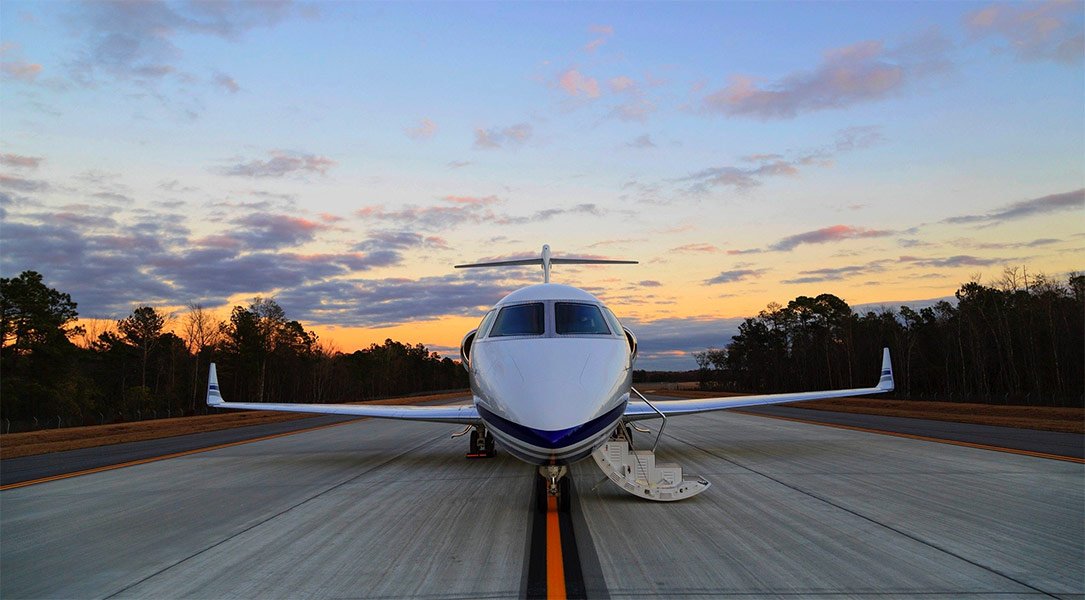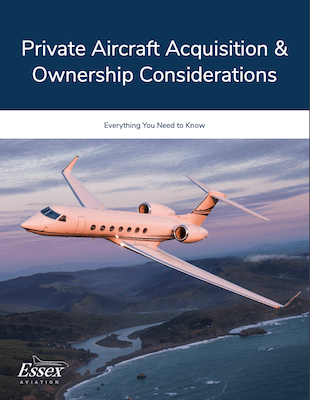
In general terms, depreciation refers to the reduction in value of a fixed asset over a period of time. In other words, it’s a measure of how much of a depreciating asset’s value has been used.
Business aircraft are a type of asset for which companies and owners can recover costs relating to their deemed depreciation in value for income tax purposes. Companies and individuals who use their aircraft for business purposes are incentivized to calculate and deduct their depreciation expense because this reduces the amount of their taxable income.
It’s important to note that there are separate methods for calculating depreciation for financial accounting purposes and for U.S. income tax accounting purposes. This article — written in partnership with Chris Younger, Senior Counsel at Crowell & Moring LLP — discusses issues relating to the latter, including income tax depreciation rules for business aircraft, the factors that affect aircraft depreciation eligibility and methods for determining the amount of depreciation an aircraft owner may deduct from their gross income each year for income tax purposes.
Key Terms to Learn
Before we begin to discuss aircraft depreciation in detail, let’s first establish a few key terms:
- Fixed Asset: A long-term, tangible asset used in the operation of a business. An aircraft is a type of fixed asset.
- Cost: The purchase price of an aircraft.
- Qualified Business Use: The utilization of aircraft in service of a trade or business.
- Recovery Period: The period of time in which the aircraft’s depreciation is accounted for; also known as the asset’s useful life.
- Modified Accelerated Cost Recovery System (MACRS): The primary accounting method used to measure fixed asset depreciation deductions during the applicable recovery period for income tax purposes.
- Alternative Depreciation System (ADS): The fallback accounting method used when MACRS does not apply, or a taxpayer elects out of MACRS.
- Salvage Value: The estimated resale value of an aircraft at the end of its useful life; also known as disposal value, residual value or scrap value. While this concept is important to determining the actual depreciation in value of a fixed asset, it is not necessary to know an aircraft’s salvage value in order to calculate depreciation for income tax purposes.
The Importance of Aircraft Depreciation
Any company or individual who owns and operates an aircraft that is used for business purposes has the opportunity to claim depreciation deductions with respect to the aircraft, thereby decreasing the aircraft owner’s taxable income. As the National Aircraft Finance Association (NAFA) states,
“Depreciation allowances provide that business taxpayers may claim an annual tax deduction to recover the cost or other tax ‘basis’ (adjusted cost) of the property for its wear and tear, deterioration or obsolescence.”
In more basic terms, aircraft depreciation presents a financial incentive for companies and individuals that use aircraft and other fixed assets in service of their business because it enables them to recoup some of the costs of their capital investment in the aircraft.
Depreciation Factors
In order to be eligible for business aircraft depreciation, you must first own an aircraft or a fractional share of an aircraft. Although that might seem obvious, it’s an important distinction because many companies and individuals lease business aircraft rather than owning them outright. These companies and individuals are not eligible to take deductions relating to the depreciation of the leased aircraft; however, the aircraft lessor — typically a bank or other lending institution — likely would be able to do so.
Aircraft depreciation works much the same way as any other form of asset depreciation. Businesses or individual owners use depreciation schedules, which “outline how a fixed asset’s costs are expensed over its useful life.” At the end of each year, the business or individual owner reviews their total number of hours or miles flown and divides them into two primary categories: personal and business use.
In order to qualify for depreciation, the business or individual owner must meet certain usage requirements — namely, that their business use of the depreciable asset exceed their personal use of it. This distinction has a direct impact on what percentage of depreciation an entity or individual is entitled to deduct. For example, if a company wanted to claim 100% “bonus” depreciation but only 60% of its aircraft usage constituted business use, that company’s depreciation allowance would be limited to 60% of the cost basis of the aircraft.
The other most essential component of eligibility for accelerated aircraft depreciation is that the aircraft’s utilization be reserved primarily for qualified business use, which is determined by analyzing both the primary purpose of the trip and each passenger’s purpose for traveling on the aircraft.
For example, a group of executives using a company plane to travel to an industry conference would be considered qualified business use. Similarly, an individual owner using their aircraft to travel cross-country for the primary purpose of conducting an in-person meeting with a business partner would also constitute qualified business use.
If, however, an executive uses their employer’s aircraft to travel with family to a vacation destination and visits their employer’s local office during the trip, this would likely not be a qualified business use of the aircraft. In this example, although the executive is conducting business during the trip, that was not the primary purpose for the flight, and the executive’s fellow passengers were members of their family traveling for personal purposes rather than colleagues or business associates traveling for business reasons.
Federal Aviation Administration (FAA) requirements relating to the operation of business aircraft also play an important role in determining whether flights will constitute qualified business use for income tax purposes. For example, the FAA might require the use of an operating structure that prevents certain flights from being counted as a qualified business use of the aircraft.
Accounting Systems: MACRS & GAAP
The primary tax accounting systems used to measure fixed asset depreciation, including aircraft depreciation, is the Modified Accelerated Cost Recovery System (MACRS).
MACRS is the fixed asset depreciation method for income tax purposes which, according to the Legal Information Institute, “allows the capitalized cost of an asset to be recovered over a period [of time, as] specified in the Internal Revenue Code, via annual deductions.”
Furthermore, MACRS:
“… allows for greater accelerated depreciation over longer time periods, which is beneficial to individuals and businesses as it allows them to deduct greater amounts at the beginning of an asset’s life, and relatively less later on.”
For example, if a business owned an aircraft valued at $20 million that qualifies for accelerated depreciation using MACRS, it would take a significant percentage of depreciation during its first year of ownership, and the depreciation allowance would steadily decrease each year over time.
Part 91 vs. Part 135 Depreciation Schedules
Business aircraft are often depreciable for federal income tax purposes under MACRS. MACRS permits taxpayers with depreciable assets to accelerate tax depreciation by allowing them to take a higher percentage of the depreciation deductions produced by those assets during the first few years of the applicable recovery period.
This acceleration of depreciation deductions is particularly true with respect to assets for which so-called “bonus depreciation” is available. One tradeoff with utilizing bonus depreciation is that less depreciation will be available to offset income in later years.
Aircraft used in commercial or contract carrying of passengers and freight, which includes aircraft used in Part 135 operations, may generally be depreciated under MACRS over a recovery period of seven years. Aircraft used in other trades or businesses or for the production of income, which are typically operated under Part 91, may generally be depreciated under MACRS over a recovery period of five years.
In some cases, aircraft are depreciable for income tax purposes, but do not qualify for bonus depreciation and/or accelerated depreciation under the MACRS system. For example, an aircraft does not qualify for accelerated depreciation under the MACRS system if it is not used at least 50% of the time for qualified business uses — more on that in a moment — or is used predominantly outside the United States.
In such cases, the aircraft must be depreciated under the Alternative Depreciation System (ADS). In addition, an aircraft owner may elect to have their aircraft depreciated using ADS. Depreciation under ADS is based on a straight-line method and thus results in equal depreciation deductions each year during the applicable recovery period.
Recovery periods under the ADS system tend to be longer than recovery periods for the same property under MACRS. The ADS recovery period for business aircraft used in commercial or contract carrying of passengers and freight is 12 years, while the ADS recovery period for business jet aircraft used in other trades or businesses or for the production of income is six years.
Understanding 100% Bonus Depreciation
On December 22, 2017, the Tax Cuts and Jobs Act of 2017 (TCJA) was signed into law.
The TCJA introduced a change to the depreciation rules applicable to business aircraft, enhancing the timing and amount of depreciation deductions for such aircraft for income tax purposes. Prior to TCJA’s passage, businesses and individual owners were eligible to immediately deduct 50% of the purchase price of a new business aircraft from their income subject to tax; this “bonus” depreciation deduction was slated to decrease to 30% by 2019.
The TCJA increased the bonus depreciation percentage from 50% to 100% in year one of ownership, with the first year bonus depreciation percentage decreasing in future years and added used aircraft to the types of business aircraft that are eligible for such bonus depreciation. This means that, when an aircraft is purchased, the owner may be eligible to write off as much as 100% of the cost of that purchase in year one, depending upon the utilization of the aircraft during that first year and subsequent years.
Under the TCJA, all new and pre-owned business aircraft acquired and placed into service to support the business for which it is used after September 27, 2017 and before January 1, 2027 are eligible for bonus depreciation depending up on the year in which the aircraft was purchased and placed in service. It’s important to note, though, that 100% bonus depreciation remains in effect through December 31, 2022. After that, the percentage of first-year bonus depreciation will decrease according to the following schedule:
- 80% for aircraft placed in service in 2023
- 60% for aircraft placed in service in 2024
- 40% for aircraft placed in service in 2025
- 20% for aircraft placed in service in 2026
For more information on how owners of business aircraft can benefit from the TCJA, please refer to our blog post on the subject.
What Happens When You Sell a Depreciated Aircraft?
As with any depreciated asset, when a business or individual owner sells a depreciated aircraft, the profit from the sale relative to the aircraft’s remaining tax basis after depreciation is deducted becomes taxable income. To the extent that such gain is treated as a recapture of previous depreciation deductions, the gain is treated as ordinary gain, with any excess profit treated as gain from the sale of a capital asset.
Find Out Whether You’re Eligible for Aircraft Depreciation
Given the benefits aircraft depreciation has to offer, it’s an exciting prospect for any corporate entity or business owner. With over 100 years of combined experience providing consultative services in the private aviation industry, Essex Aviation Group has the necessary qualifications to help you determine whether you may be eligible for aircraft depreciation and can connect you with tax experts, such as the professionals at Crowell & Moring LLP, who can provide additional assistance.
Find out whether you’re eligible today — contact Essex Aviation to get started.







